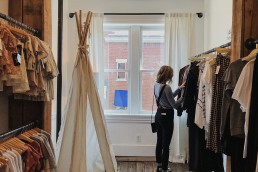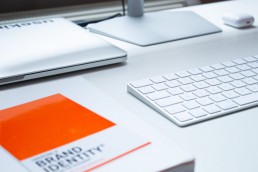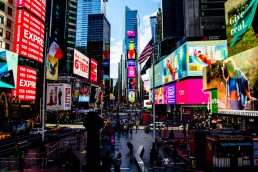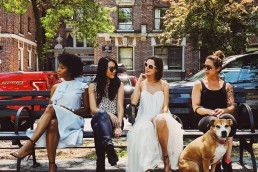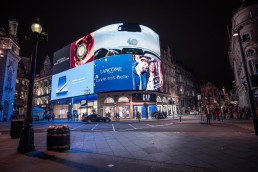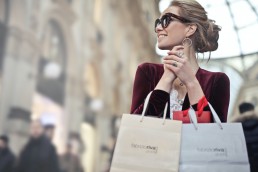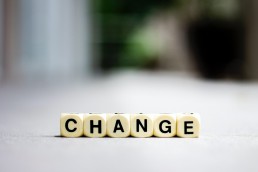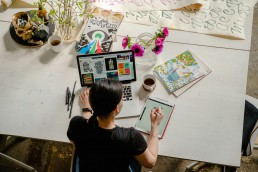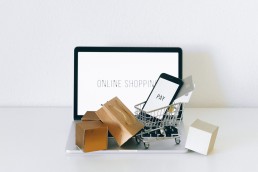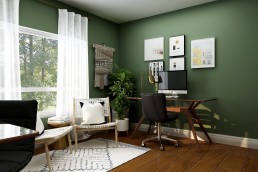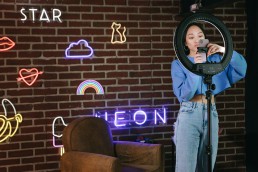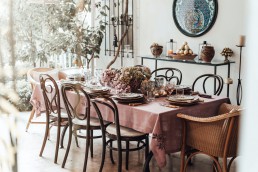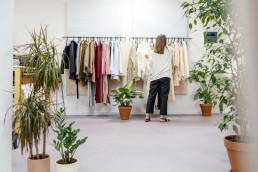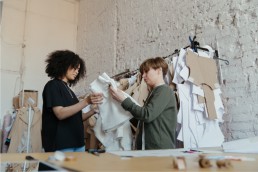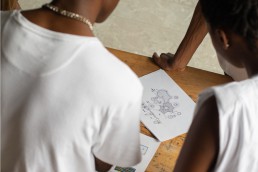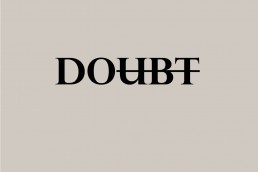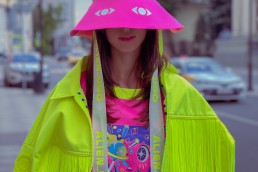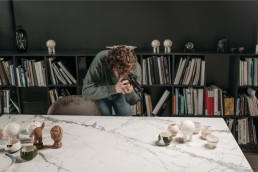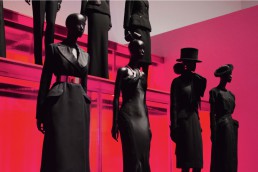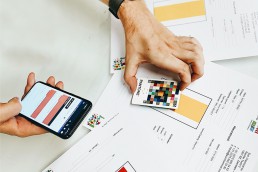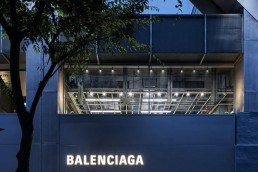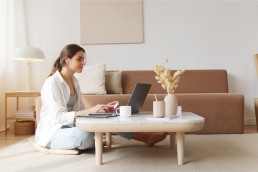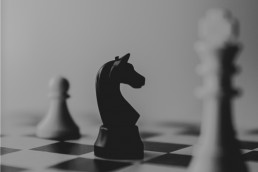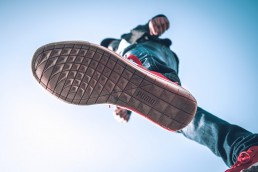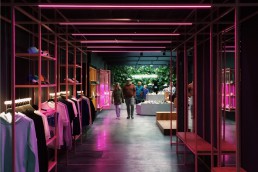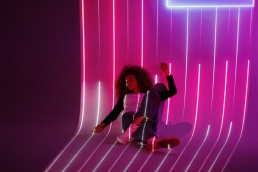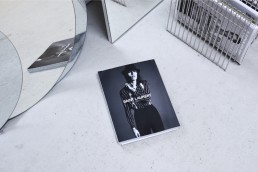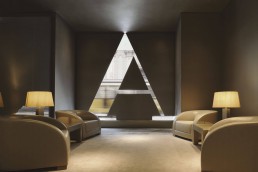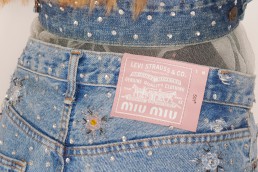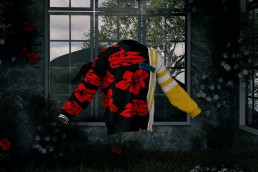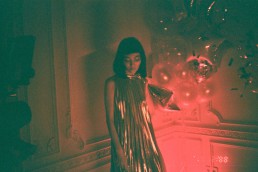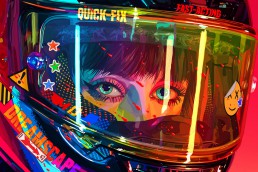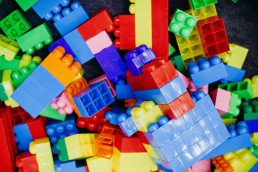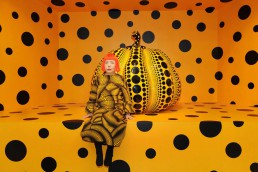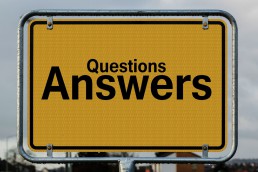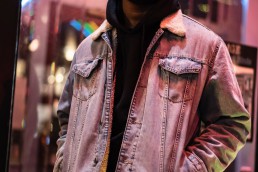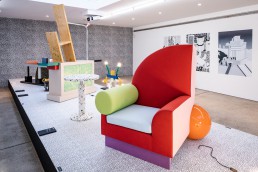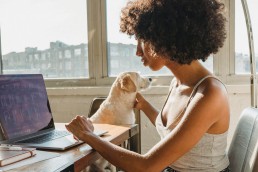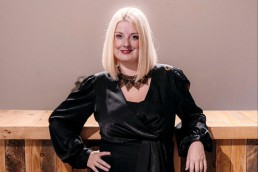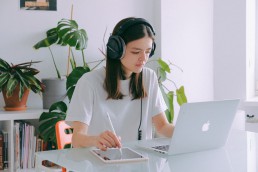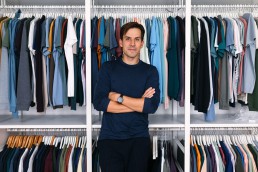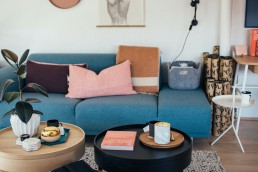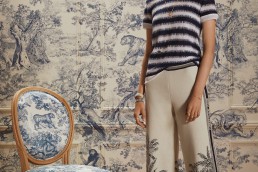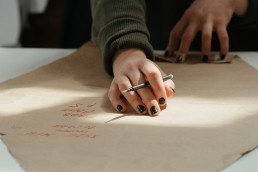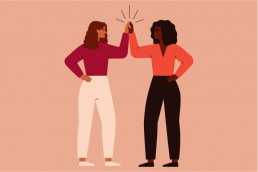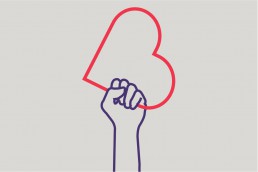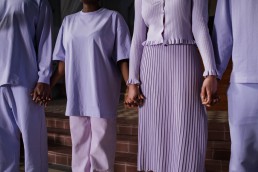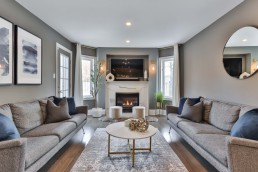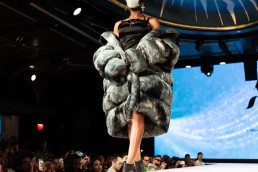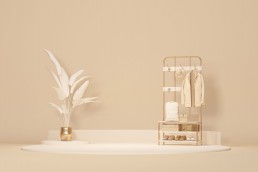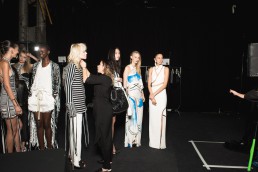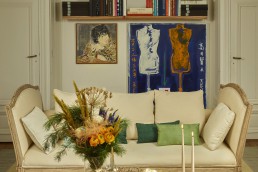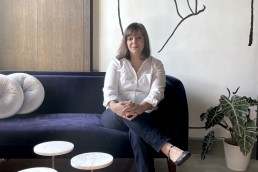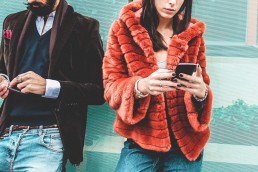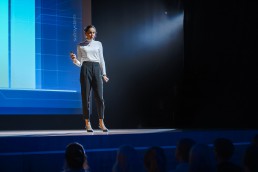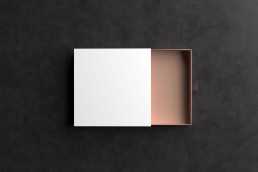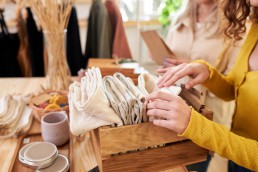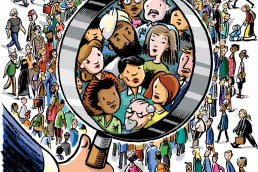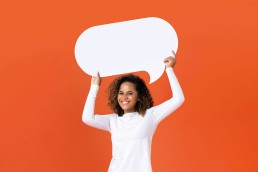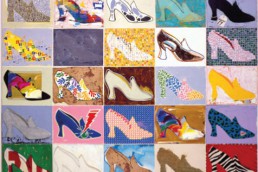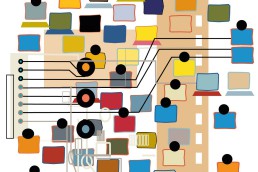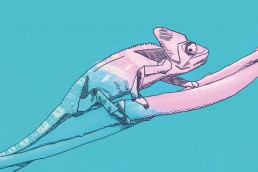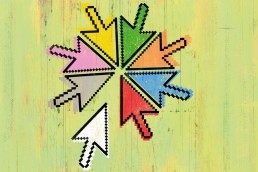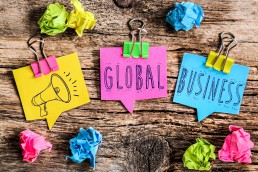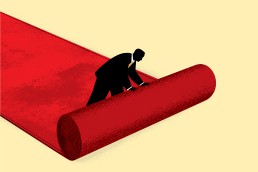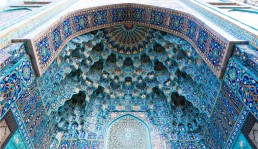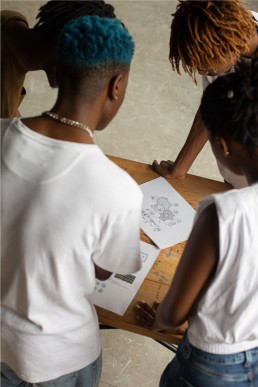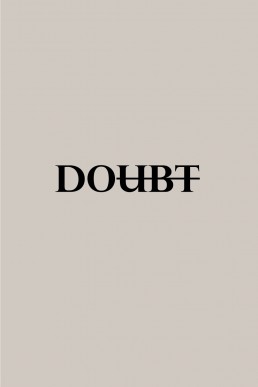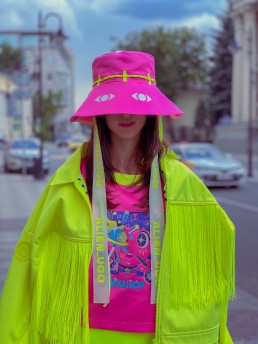The Best Interior Design and Home Interior Tips to Come in 2022
Sustainability and business are topics leading the global conversation, from apparel to tech enterprises. Today we share key points about the B Corp certification and why the fashion industry uses it as a positioning strategy.
As an Interior Design and Deco-enthusiast, you need to keep up with the latest emerging trends. Look for new artistic expressions, groundbreaking shapes, and unconventional materials.
Interior Design allows us to reflect our personality through spaces, it helps outline our character and the type of environment we cherish. The possibilities of mastering Interior Design are endless, you can always change and alter your surroundings to be more aesthetically pleasing.
This year, after lockdowns and staying at home longer than usual, it is reasonable that decoration waves ahead bring us to balance, redefinition, as well as healthier indoor environments.
Just as in Fashion, Interior Design ideas come back and go. Popular trends can update a classic style or be helpful to rethink the functionality of your space. In both cases, the decoration aesthetic waves help to give an unexpected twist to our home, office, or recreational spaces.
Below is a list of the best Interior Design and Home Interior tips for 2022.
Green Is the Most Wanted Color
From warm greens to vibrant “clickbait” green, eucalyptus, or jade, the green palette has expanded around deco color palette and even through fashion. Emerald green and Sage green are also among this year’s favorites.
Ode to Nature: Outside Spaces Slide Inside
A deep connection with nature and all of its forms and shapes. This nature-trend focuses on bringing greenery into your room. Plants are the stars, complimenting warm browns, wood finishes, and nature-type furniture. Flowering plants are a stylish choice to splash a little bit of color in the space. The more (plants), the merrier. This tendency is valid also to focus on your outdoor space, such as porches, balconies, and backyards; in 2022, they will be taking the spotlight.
Antiques and Retro-Vibe
Retro themes are on the rise this year. Burnt Orange and Tan are colors that blend perfectly with Mahogany. From Bauhaus, mid-century, and Scandinavian furniture, nostalgia is flooding everything. Warm neutrals and a touch of retro in decorative objects can give a unique look to your place. Keep visiting your local antique shop to find bargains and unique pieces to be restored and introduced in your spaces to make a deco statement.
Sustainable Attitude and Materials Are Here to Stay
The sustainability approach is not a trend. The encouragement of a greener design is essential in any design studio and decoration project. The popularity of natural materials like linen, wood, and stone is trending. Clay, ceramics, organic shapes, and tactile finishes in the walls are part of this trend. Recycled or reused materials in decoration are mandatory to have an eco-friendly design perspective.
Multifunctional Spaces
The pandemic is making us rethink everything around us; one of the strengths of 2022 Interior Design trends is the versatility and approach to our home spaces. Is it your kitchen table or is it your work desk? Some workspaces are becoming spaces to play or to develop a hobby. Living rooms can serve different purposes and activities. A terrace can work as an office, and indoor spaces are continuously transformed into what our needs require them to be.
Let’s Get Physical: Home Gyms and Meditation Spaces
More popular than ever, the at-home exercise routine has become an integral part of our daily life. Interior designers and decorators expect fitness-in house is likely to remain popular. A few rearrangements of a room can make it work to perform your favorite routine or simply disconnect with your daily meditation.
Large-Scale Patterns and Biophilic Motifs Everywhere
Natural lighting and biophilic design elements will strengthen its presence in 2022. Exciting and eccentric wallpapers nature-themed are the perfect example of the trend. Also, the Goblincore trend (wild side of nature and forest mania) is bringing back vintage small-shiny objects in an earthy theme (mushrooms, leaves, mud) to experiment in our home.
The best interior designers and decorators take the best of trends and deco-moods and adapt them into any project. Pay attention to all tendencies to keep your creativity at its highest level.
Fernando Aguileta de la Garza (ELLE Education Business)
Fashion Brands on TikTok: What They Are Doing to Create Online Buzz
The social media darling, TikTok is breaking rules and formats on how to present fashion products and brands. Today we share why brands have to be in the most coveted social media app of the year.
The social media app landscape is evolving drastically; tech companies are creating new app features for users to play, have fun, and spend time immersed in all types of social platforms.
TikTok is definitely one of the most ludic and eye-catching apps in the social media marketing strategy. Its whimsical allure is a teen magnet and the place-to-be for fashion brands that want to interact with Gen Z.
Some traditional brands do not know what is the best way to approach TikTok as it has been labeled as the dancing-teens app. That is partially true, although this is an excellent moment to build an innovative communication strategy, as TikTok has more features and an immediate language beyond just dancing videos.
Besides its rapid user growth, TikTok provides the fresh approach that the fashion industry has been looking for in social media to engage with a younger generation.
If you have a fashion brand or a lifestyle project, TikTok can help you to create authentic and relatable content; as the user experience in the app is really intuitive, you can engage in watching other brands’ strategies for benchmarking analysis.
High Fashion and beauty brands are betting hard on TikTok to market new products and create seasonal campaigns.
ByteDance, the Chinese parent company for TikTok, revealed last September that the app has been downloaded over 2.6 billion times worldwide and has reached 1 billion active global users. The app is now available in 154 countries, a totally viral sensation thanks to the short-form video format.
According to Statista, in February 2020, TikTok “reached a total lifetime user spending of 300 million US dollars on Google Play and the App Store. The ByteDance app generated about 50.4 million US dollars from user spending during that month”.
In terms of demographics, as of March 2021, “users in their teens (10-19 y.o.) accounted for 25 percent of TikTok’s active user accounts in the United States”.
According to App Ape, “users aged 20 to 29 years accounted for 22.4 percent of the video-sharing app’s user base on the Android platform”.
These outstanding numbers are proof of the shift of a generation of heavy smartphone users constantly in touch with trending and viral content.
Fashion Brands on TikTok: Campaign Examples and Viral Videos as a New Form of Communication
TikTokers engage in a direct and agile way when using the app. Following, commenting, and liking each other’s posts are the common ground for every social media network. However, TikTok users have encouraged lip-syncing, dancing, copy-cat video making, and taking an active part in viral challenges.
According to the ranking of the most popular TikTok users worldwide 2021, published by Statista Research Department, TikTok’s digital ecosystem has created its own teen internet celebrities such as Charli d’Amelio (123.5 million followers), Khabane Lame (107.54 million followers), Addison Rae (83.5 million followers), and Bella Poarch (75.4 million followers).
Marc Jacobs has advertised on TikTok by launching the Branded Hashtag Challenges #PerfectAsIAm, in summer 2020, and #PerfectAsWeAre campaign in June 2021 (a celebration of Pride and encouraging self-love and individuality). They each beat reach records at 10.4B views, and 13.7B views respectively. The TikTok Duet Feature was the magic key into the brand’s success as well as featuring key Tik-influencers, such as Rickey Thompson, Jojo Siwa, and Bretman Rock.
When Fendi arrived at TikTok, the roman-based luxury company ran five In-Feed Ads, all driving users to its new brand profile. The purpose was to generate widespread awareness and brand engagement. In-Feed Ads are recommended for mass exposure, and organic appeal, as they run natively on the “For You Feed” leading to a more personal experience.
Fendi’s campaign “F is for…,” in which the fashion house collaborated with world-famous US singer Sabrina Carpenter, the campaign earned 4 million views and drove a 5.8% engagement rate. The ads also achieved an average click-through rate that outperformed its benchmark by over 158%, and the strategy led to 15,000 new brand followers.
Shein’s social media marketing strategy is based on user-generated content. Inside TikTok the brand is best known for its “Fashion Clothing Hauls” and “Shein vs Reality” using hashtag #SHEINgals. The brand works with paid partnerships with super-influencers and less-known creators (from 2K to 50K follower number range).
TikTok encourages brands to use the platform more playfully and excitingly to engage with a broader audience that looks for an authentic and community-driven approach.
Fernando Aguileta de la Garza (ELLE Education Business)
Why Designer Homeware and Tableware Are Trending
Decoration and tableware have become an essential part of any interior design, or lifestyle brand, offering a vital experience, and a way of living that starts at the table.
The art of setting the table is an ability based on projecting our style into the little details to please the diners. Being a host means taking care of every aspect to make any culinary event a wonderful success.
In the last year, and thanks to the increased time spent at home, many brands and designers have paid more attention to offer attractive designs within their homeware lines, whether these are decorative objects, cutlery, tableware, or furniture.
In a world where everything is photographed via Instagram, thousands of images with table sets and decorative ideas through the Internet work as a source of inspiration, helping us to get into the hunt for f those objects to decorate both our home and table daily, as well as our special events.
Dressing the table is one of the talents that every interior designer and decorator should have. Making attractive placements, and knowing the most suitable combination of materials- even with some unexpected ones- you will make the aesthetic arrangements to work better, and to keep in mind a certain style.
The rise of home lines from designers and luxury brands is due to more clients looking to create a lifestyle statement with their home accessories, communicating a message of taste and their favorite design references.
Although homeware is not a recent invention, we can find a notable upward trend in tableware, driven by small gatherings and social media as a medium for communication, inspiration, and the exchange of décor information between the users.
Set Your Look and Set the Table: Fashion & Dinnerware Décor
Decorators and interior designers are up-to-date with the latest product launches of luxury brands and independent designers. A market that prescribes trends and sets the standards in color palettes, textures, and materials on the rise.
Many fashion brands translate their lifestyle to the customer through their homeware, accompanying them with its fashions, and also dressing the table.
Homeware is a brand’s extension that the customer can use to build its personal style with many options, from minimalist, floral, conceptual, and classic tableware to furniture collections.
For example, Armani Casa celebrates its 20th anniversary reflecting the constant yet subtle dialogue between tradition and innovation. Designer Giorgio Armani created an elegant and timeless home style, originated from the curiosity of exploring new environments beyond fashion. The Logo Lamp emerged in the early 1980s, as the hallmark of the entire line. Mr. Armani is a pioneer designer using the dynamic between minimalism and décor.
Its iconic bar cabinets are the perfect match for any social soirée. Royal, a hand-crafted bar cabinet marked by details reminiscent of a revisited sécretaire, for glasses and cups, with shutter closure, a limited edition of only 88 pieces for the SS21 collection. The cabinet is clad in a special weaving of paper and cotton reminiscent of a Japanese tatami and textured fabrics typical in Giorgio Armani’s aesthetics.
Gucci Décor is the latest launch inside the creative universe of Gucci’s Creative Director Alessandro Michele. The line offers an eclectic and a mix-match aesthetic, very reminiscent of the brand’s image, featuring the House motifs, patterns, and codes. The line also includes trays, cushions, mugs, and metal folding tables designed to personalize the home.
Part of the porcelain collection includes vases produced by Richard Ginori, the renowned Florentine company founded in 1735.
Dior Maison has been “an ode to the art de vivre and entertaining à la française” perpetuated by the house of Christian Dior since its foundation. Creative Director, Cordelia de Castellane, has maintained that spirit since 2017, with a high standard collection of home plates, place mats, tablecloths, glasses, platters, and much more created in extraordinary materials.
The homeware and tableware line has permanent collections, as well as capsules and seasonal collections to infuse novelty and freshness to the client’s table. There are several inspirations around Dior Maison, from Monsieur Dior’s muse of muses, the leopard print, featured in The Blue Mizza collection, to The Granville collection, a tribute to the flowers and the garden of his villa in Normandy, displayed on carafes, glasses, napkins -embroidered and hand-painted- as well as on dessert plates.
Home decoration and crafting showstopper tables are very useful knowledge for interior designers, to create cozy environments and do remarkable statements for any home.
Fernando Aguileta de la Garza (ELLE Education Business)
What is a B Corp and Why High-Fashion Is Embracing the New Certification
Do you want to keep your knowledge of Interior Design on track? Today we share the best decorative tendencies for this year.
B Lab is a global network creating standards, policies, and tools for business, their purpose is to serve “a global community of people using businesses as a force of good”. They are a nonprofit entity that certifies companies willing to achieve the B Corp status which is changing the “business as usual” way of proceeding inside the landscape of industrial and corporate practices.
The network includes over 8,000 benefit corporations, over 100,000 companies managing their footprint with the B Impact Assessment and the SDG Action Manager. The community includes over 3,500 B Corps in 70 countries and 150 industries. The numbers are impressive considering that the organization B Lab was founded 15 years ago.
The vision of co-founders Bart Houlahan, Jay Coen Gilbert, and Andrew Kassoy was to use the power of business to solve social and environmental problems. Their goal is to drive systemic change through the B Corp certification, the use of the GIIRS Rating and Analytics platform, and promote Benefit Corporations.
This tripartite dynamic pursues the certification of companies that fulfill the B corporate standards; classify them to attract investment capital according to those social and environmental efforts; encourage business entities to have a dual purpose: generating a profit and promoting the public good.
The B Corp certification meets “the highest standards of verified performance, focus on public transparency, and legal accountability”. The B corp vision is to enjoy more shared and durable prosperity, redefine success in business and build a more inclusive and sustainable economy.
The B Corp philosophy wants to create benefits for all stakeholders, going further than just shareholders. The companies earning the B Corp certification are ruled by a Declaration of Interdependence, which englobes all goals mentioned before. They are committed to a structural change on market interactions as “we are each dependent upon another and thus responsible for each other and future generations”, states the declaration.
For brands to get the B Corp certification, they must achieve a minimum verified score on the B Impact Assessment. It is a 360º assessment of the company’s impact on different business areas such as, people, environment, community, governance, and customers.
The topics under review are Ethics & Transparency; Financial Security; Career Development; Health, Wellness & Safety; Diversity, Equity & Inclusion; Civic Engagement & Giving; Customer Stewardship; Resource Conservation; Environmentally Innovative Wholesale Process, among many other categories.
B Corp Certification is administered by Standards Analysts at B Lab, and they are located at B Lab’s Pennsylvania, New York, and Amsterdam offices.
The B Impact Scores have been compared against all businesses that have completed the B Impact Assessment, in which 50.9 is the median score for ordinary businesses, and 80 is the minimum score to achieve the B Corp status.
High-Fashion Takes Responsibility: The Race for the Certification
In recent months, several well-known fashion brands have announced their B Corp certification as part of a more engaging way of doing business and reinforcing a purpose-driven strategy. Fashion companies with B Corp status can be found inside a directory at bcorporation.net.
Chloé achieved the certification last October. It all started in June 2020, in line with their rebranded mission, “Women Forward. For a Fairer Future”. Creative Director Gabriela Hearst, a sustainability advocate, is behind this new brand positioning, and Richemont, as a parent company, supports this new framework to accelerate and guide the brand’s transformation.
“It is our strong belief that we need to take full accountability for the impact we have on people and planet, injecting purpose across everything we do, transforming how we do business and actively participating to build a better world”, stated Chloé CEO, Riccardo Bellini.
Chloé’s Overall Impact Score is 85.2, and it is not alone in the B Corp community. Brands such as resale luxury platform Vestiaire Collective scored 89.4, and Parisian-style brand Sézane founded by Morgane Sézalory, scored 82.6 last September.
These corporate movements show good faith inside the luxury holdings practices, as profit was one of its main drivers. The B Corp certification strengthens the brand equity and updates the brand towards the B Economy that pursues a fair future for all. The certification urges every high fashion brand that wants to certificate to have a defined purpose which can benefit brand positioning.
Certainly, transparency is a new territory for high-fashion and contemporary brands, but not completely a new one for small, independent, or previously committed apparel brands.
Patagonia has had a B Corp certification since 2011. The brand had gained 17 recognitions for top-performing companies achieving a 151.4 score in the last year. The brand increased its performance by around 30% since the first certification ten years ago.
Some medium-sized brands from different categories such as footwear, bags, accessories, jewelry, home clothes, glasses, jeans, sportswear, swimwear, have been certified for years, giving the example that to obtain certification, you do not have to be a big company.
Perhaps luxury has arrived a little bit late to the table, but better late than never. It is a great start towards sustainability and transparency to build a better future for luxury.
Fernando Aguileta de la Garza (ELLE Education Business)
The Difference Between Interior Architecture and Interior Design
Both career paths are similar, yet they have significant differences in practice. Today we explain relevant aspects of both careers centered in interior and functionality.
You might have wondered what career path to take if you are interested in decoration and buildings. Interior Architecture and Interior Design both involve creating indoor spaces; although they are complementary, they have different approaches in practice.
The requirements and responsibilities may vary between them. Keep reading this article to find out the main certifications and skills required in each field, so you can decide which area fits better with your career goals.
Interior Architecture is a profession that blends design and building functional spaces, focusing on the technical aspect of the task. Interior architects manage complex projects, meet with engineers, constructors, interior designers, and even other architects to discuss, plan, and execute the project.
Interior Architects oversee construction sites and teams, ensuring security, quality development, and supervising the resemblance of the layout to the actual space. They specialize in designing and also building spaces from scratch.
On the other hand, Interior Design mainly focuses on aesthetics rather than functionality; it takes inspiration from art, forms, history, or conceptual ideas to fulfill its mission. An interior designer works from a finished space, creating atmospheres and incorporating aesthetic elements such as flooring, wallpapers, furniture, curtains, and artwork or decorative pieces.
Interior Designers develop lighting, color schemes, textiles, finishes, materials, and textures ideas. Their job is to work hand-to-hand with the client to understand how they intend to use the space and its requirements to make it more comfortable and aesthetically pleasing.
In both professions, there is overlap between activities and responsibilities. For example, both have to create a timeline for the project execution, keeping deadlines under control. A time management chaos can raise the cost and energy of all involved.
Interior Designers and Interior Architects are familiar with design software for showing the project’s layout. They use computer-aided design (CAD) and drafting and building information modeling (BIM) applications, this way they can virtually create the space in a fast and efficient way. They also supervise the budget, including cost estimates, supplier orders, and required staff.
In addition, they manage project meetings to follow up on signs of progress and discuss new options in case of any inconvenience found on the way.
Surface or Structure: Interior Design vs. Interior Architecture
As previously explained, both career paths have some similarities as their goal is to create and build beautiful spaces. The main difference perhaps has to be with certifications.
Architects must have a license to practice architecture. In this case, a degree is essential to work in the field. Architecture boards (national or local) set industry-recognized standards to pass a licensing exam. Interior Designers, on the other hand, may not need a license to practice according to national regulations. Nevertheless, they can learn the practice by studying a bachelor degree or taking a course specialization or master’s degree.
Interior Architecture usually turns one type of space into another, analyzing and testing materials of the existing interior structure to be aware of any technical requirements.
Interior Architects are used to refurbishing existing spaces, designing and adapting the new space taking into consideration the structural elements such as electrical, plumbing, heating, and air-conditioning.
Interior Designers, on the contrary, do not modify structure elements unless they are mandatory for the project. If required, they will work with a multidisciplinary team to change the building structure. However, their main focus is to design and optimize the previous room spaces or elements to benefit the global project.
If you feel attracted to Interior Design, you must know there are plenty of specialization areas to choose from. You can find yourself working on residential projects or be more interested in corporate and commercial spaces, such as offices and retail ventures.
Many Interior Designers may focus on renewing baths, kitchens, living rooms, or bedrooms, the possibilities in residential projects are infinite. Whatever your career choice may be, now you have some specific information to help you decide which path is better for you.
Whether it is Interior Design or Interior Architecture, both offer you a profession full of creativity, challenges, and beautiful ideas.
Fernando Aguileta de la Garza(ELLE Education Business)
The State of Adaptive Apparel Market and Inclusive Design: Making Fashion for All
Inclusivity and diversity have been headlining topics in the fashion press last year, however, an inclusive communication campaign is not enough if it does not translate into actions inside the company’s product lines. What is the adaptive clothing market? And why is it relevant that design be for everyone?
Being truly inclusive is to invite all people to sit at the same table. Unfortunately, inside the fashion world, this does not happen very often.
As a system, fashion reinforces individuality instead of collectivity and promotes exclusivity instead of accessibility. The exclusion is a component of its social dynamics, and fashionable designs sometimes become a privilege for only a few.
People with different attributes from the average person continually face these dilemmas daily. Whether due to a genetic disposition, an accident, or a disease – punctual or degenerative – people living with a disability (PLWD) find the simple act of dressing complicated.
According to Statista, the adaptive clothing market represents a market value of $300 billion in 2021, with a global growth outlook of 16% by 2024. Coresight Research estimates that the U.S. market will grow to $54.8 billion by 2023.
These indicators show the importance of a group of active customers that have been continuously invisible under the umbrella of disability and shopping clothes only from the medical perspective.
In this context, the style factor is equally significant than function because fashion clothing can contribute to increase their self-esteem and also their self-sufficiency, as they can use fashion as a way of expressing their individuality.
Disabled World defines adaptive clothing, or adapted clothes, “as clothing, garments, and footwear specially designed for people with physical disabilities, the elderly, the infirm and post-surgery patients”.
The users of adaptive clothing may find themselves in difficulty for self-dressing “due to an inability to manipulate closures, such as buttons and zippers, or due to a lack of a full range of motion required” due to nervous diseases, or physical handicaps, to illustrate a wide range of cases.
Fashion, which always promotes style and trends, frequently has not considered the functionality of garments for people with disabilities or those with a non-normative body.
Design as a function of course provides benefits, as adapted fashion products improve the life of PLWD. These specialized lines provide nonrestrictive comfort to the wearer and an easy way of dressing or undressing.
An Opportunity for Fashion’s Inclusivity Design Practices
PLWD should not be framed as just another market segment. In doing so we would fall into the trap of exclusion. Universal Design tries to erase that notion from a variety of disciplines such as architecture, industrial design, and fashion.
Inclusion and usability in the design of garments for everyone (regardless of whether there is any physical or mental impairment) is a great challenge for any contemporary designer.
First, the clothing must be functional to be truly wearable, and second, a balance between ergonomics and aesthetics is a must-do, this way the design is not solely contingent on its function.
It seems a paradox, but in reality, “Universal Design would not be needed if the disability was not part of being human”. According to The Universal Design Project “some people have significant functional needs that require specialized design. If universal design is the foundation for design, adding specialized features as-needed is much easier and more cost-effective than if a design is fully specialized”.
The fashion market is still segmented by specialized design mainly due to business’ inertia and a lack of knowledge over the subject. This shows, there is still a long way to go, although several brands and independent projects are giving light to this universal concern.
For example, Tommy Hilfiger launched “Tommy Adaptive”, a fashion line created with one goal in mind: “to make dressing easier for everyone… only quality clothing that offers solutions”. Their client’s feedback had been the best way to improve the line. This constant insight has helped the brand to produce better clothing options.
Brands such as Collina Strada (its FW21 catalog features clothes for PLWD), Chromat, Christian Siriano (in a possible collaboration with Selma Blair), Nike, Target, or Asos are some companies that are making tangible efforts inside the adaptive market.
Fashion’s long journey to embrace inclusivity is necessary as this approach can change business mindsets and, hopefully, will put all humans (no matter how different they might be), at the center of the design practices of the future.
Fernando Aguileta de la Garza(ELLE Education Business)
How to Write a Press Release for a Fashion & Lifestyle Brand
Today we share some easy steps to create a press release, a constantly evolving but recurrent piece in the fashion communication field.
A press release serves to inform, persuade, or communicate something specific the brand needs to publicize to its audiences.
A press release is a common fashion communication material that Public Relations managers or Brand Communication Managers use frequently to keep the media updated about brand news, product launches, and relevant information.
Thanks to social media networks, information's speed has increased lavishly through the internet; in this ever-changing context, the traditional format of the press release needs to adapt and be flexible to gain a wider reach.
What, for Who, and Why Is This Relevant?
The first aspect you need to be aware of is what type of information you want to communicate. Whether it is launching, a piece of breaking news, a new collaboration, or a position appointment, you need to know for sure what you are promoting.
Second, you must define the press release objective; what do we want to achieve with the spread of information? Sometimes the brand wants to get media coverage, other times just to give journalists a scoop. Your communication objectives must be aligned with the expected reaction you are looking for in media outlets.
The third aspect to consider is to think through the relevance of the information you are releasing. Journalists receive hundreds of emails in a week. We must evaluate if the information is worth the click or is it better to publish it on your social media account.
How to Write a Press Release
Press releases are used independently or as a part of a media kit available when a journalist requests brand information.
When mailing a news release, it is convenient that the document is presented on the brand's stationery. The letterhead must have your company's logo and contact information.
However, some communication managers place the contact information at the end of the page, including contact person, email, telephone number, and the mailing address, including the headline "FOR MORE INFORMATION".
It is recommended that you find a specific graphic format for press releases; this way your audience will be aware immediately that the text is a corporate message. Margins for a news release should be one to one-and-a-half inches on all sides.
On the heading, type "NEWS RELEASE" or "PRESS RELEASE" in big letters -you can use 24-point boldface type- and include the date and location of the release. Below that, you should highlight the impact of the information; if it is urgent, you should type "FOR IMMEDIATE RELEASE".
You can leave about two inches between the headings and the headline. The headline in a press release is a statement, written in present, or in the recent past tense. The headline must generate media interest and summarize your story's main point. Feel free to include your brand's name in the headline and brand keywords if applicable.
After the headline comes to the full text. You can double-space it for better readability. The text should describe the information concisely in one page (the recommended structure) or at most two; more than two pages in a news release is considered off-format. If your press release is more than one page, type "more" or "over" at the bottom of the page. This indicates that more information follows.
A newsworthy story should convey the “who”, “what”, ”where”, and “when”, resembling the lead in a newspaper article. As for the recommended format, you should write your press release as an inverted pyramid. This written structure places the most important information at the beginning of the story,then,the less and least significant information follows.
As a communication manager, you must use past tense verbs to attribute quotes in a press release. Also, be precise, objective, and concise, avoid promotional language or vague statements.
Lastly, proofread to eliminate spelling and typing mistakes; now, you are ready to send your press release to your targeted audiences. Give the press release a follow-up, and always respond by email or by telephone quicker as you can. You would not want to miss an opportunity to be published.
Fernando Aguileta de la Garza(ELLE Education Business)
Key Innovation Principles to Develop Your Lifestyle Business Strategy
Fashion and Lifestyle businesses are including innovation inside their core business operation strategy. Today we share some knowledge about innovation, and how to integrate it into your brand or service.
You have probably heard about innovation, the buzzword inside all businesses and the service sector. If you are thinking of launching a brand or developing a business idea, we recommend you dig into innovation frameworks and theories, to get fresh ideas to rethink, and improve your business model.
Innovation is more than a fad; it fosters creative solutions and alternatives in a complex world. Business models should respond to three main dimensions of the company's activities. Value creation, value capture, and value delivery are interconnected areas that can change a business model framework as value is perceived differently by the organization, the market context, and consumers.
According to economist David Teece, the business model defines how the company creates and delivers value to clients and then captures a portion of this value to make a profit and grow.
An innovation and economic history authority, Joseph Alois Schumpeter in The Theory of Economic Development defined innovation as "the commercial or industrial application of something new -a new product, process, or method of production; a new market or source of supply; a new form of commercial, business, or financial organization".
The Oslo Manual, developed jointly by Eurostat and the Organization for Economic Co-operation and Development (OECD), is part of an initiative devoted to the measurement and interpretation of data, relating to science, technology, and innovation. According to The Oslo Manual, a crucial part of innovation is implementation; "new processes, marketing methods, or organizational methods are implemented when they are put into practice use in the firm's operations".
Types of Innovation and Today's Innovation Context
Besides its implementation, industries worldwide are undergoing a paradigm shift due to the Internet of Things (IoT), pushing another industrial revolution where man and machines are co-working to develop human-user-centered products and services faster than ever.
The Industry 4.0 is characterized by a digitalization perspective with connected devices, Big Data and data analytics, electric vehicles, 3D printing, artificial intelligence (AI), all evolving to a new frontier.
The concept of this evolution in Industry 5.0, it is defined by authors Skobelev and Borovik in On the Way from Industry 4.0 to Industry 5.0: From Digital Manufacturing to a Digital Society. A new industry "characterized by digital smart society, the integration of virtual and physical spaces, IoT, robots, augmented reality, innovation ecosystems, brain-machine interface and human centrality of technology" that will rule future innovations and human-centered business models.
The Industry 5.0 perspective intersects human intelligence with cognitive computing systems for extreme personalization. The new idea should be technically feasible, financially viable, and marketable products that can create value. We cannot claim innovation if the process does not create real value for users or customers.
Integrating Innovation Frameworks to Improve Your Business Idea
We previously discussed the relevance of fostering innovation inside the business model aligned with the future perspectives. You can integrate some innovation frameworks to analyze the Unique Value Proposition (UVP) of your brand and detect if you are complying with innovation criteria.
Your type of innovation will depend on two main factors: the market and the used technology. If you focus on the market, you must determine if your innovation proposition creates a new market or address the existing one. If you decide to focus on technology, the criteria is the same; does your innovation use a new type of technology (or even create it)? Or does it use an existing technology?
The Ten Types of Innovation framework created by Doblin Consulting can be a diagnostic tool to identify your internal approach to innovation. This framework works to analyze competitive environments and research how your competitors deal with market changes and ongoing innovations. In addition, it can help you to foresee potential opportunities.
You can improve the configuration of the business system (profit model, network, structure, process); your offering (product performance, product system); the experience you deliver (by service, channel, brand, or customer engagement).
According to Fast Company, some 2021 brand innovation cases came from brands, such as Farfetch, Lulemon, Goodee, or Renewcell.
Some of the breakthroughs are: digitizing inventory to help thousands of brick-and-mortar stores to deliver service during a pandemic; establishing new ways of creating brand community through streaming fitness classes; selling worldwide-curated design through an e-marketplace for a social cause; fabricating new clothing materials based on discarded textiles replacing wood-based fibers at large scale.
Innovation can act as a catalyst to improve your business development, establish a balanced purpose, and unleash creativity.
ELLE Education Editor(ELLE Business)
What Business Strategy Take to Build Your Brand
If you are building a brand from scratch, and want to create a strong strategy behind the company, today’s article is for you; we present you with essential business insights that you can apply to your project.
In lifestyle and fashion business, managers often think about profit and growth, while the creative team develops the design and brand aesthetics, however, both paths are two sides of the same coin. The brand's objectives must be aligned to achieve company objectives, whether they are financial or focused on image.
Marketing author and management expert Peter Drucker defines strategic planning as embracing analytical thinking and measuring business resources to action. Drucker argues that strategic planning is "making present decisions systematically and with the greatest knowledge of their futurity". To expand on this notion, Drucker explains the system requires "entrepreneurial risk-takes to carry out these decisions and measuring the results of these decisions against the expectations through organized,[and] systematic feedback".
In a brand's context, strategy means a set of ideas, routes, and procedures involved in the achievement of an objective. These decisions act interdependently, strengthening business management through time and thus other areas in the company.
Key Aspects to Develop a Solid Business Strategy
As a new brand, having a strategic plan is mandatory if the goal is to enter and compete in the market and succeed. For Drucker, it all starts with the mission of the organization and the need for a strategic vision.
The main characteristics of a strategic vision are:
- It charts an organization's future strategic course—defines the business composition in the short and medium-term (3-5 years).
- It identifies business activities to be pursued.
- It defines the business' future market position.
- It defines its future customer focus.
- It defines the kind of organization the business wants to become.
According to marketing and strategy expert Michael Porter, author of the five competitive forces framework, applied strategy is a "matter of working out your company's best position relative not just to pricing pressures from rivals but to all the forces in your competitive environment”. For Porter, business strategy is a matter of benchmarking and adopting the best market practices, in addition to being focused on a few key success factors, such as core competencies, critical resources, and the capacity to respond to the ever-changing market shifts.
Marketing Actions and Business Development: What Areas Should I Strengthen Inside My New Brand?
These are three fundamental axes that will give us a useful framework of strategic operations, and will help us to decide the best strategy to follow depending on the nature of our brand.
- Action: This area is active; it demands our brand's expansion or a market conquest. This area is linked to the company's operational marketing. For example, internationalizing the brand, launching new lines, opening new points of sale overseas, or developing a new sales approach.
- Analysis: This area is reflective; it demands to understand -deeply- the target markets. This area is linked to business units and the company's strategic marketing. For example, if we want to analyze the feasibility of customizing our products, creating product licenses, outsourcing processes versus working in-house, and outlining competitive market communication strategies to do what everyone else does but reducing the allocated budgets.
- Culture: This area is linked to the mission and purpose of the business; it wants to highlight the internal business values and philosophy of the brand. This area is related to a corporate brand strategy as well as image and communication actions. For example, we can create a brand culture that goes beyond economic growth, as we can promote and link the brand with artistic and cultural activities.
Strategy is planning; marketing is developing and setting actions on track. Your brand's path must be as singular as your Unique Selling Proposition (USP) to set you apart from the rest and do something no one else can do.
A solid strategic vision and a strong business operation are areas that must be aligned with purpose. Remember, this approach has nothing to do with profit, as Drucker states, "the purpose of a business is to create a customer”.
Fernando Aguileta de la Garza(ELLE Business)
The Color Industry: How Colors Define the Social Mood and Guide Fashion and Lifestyle Projects
Colors are relevant in fashion and lifestyle. Color developers present a new range of color tones to enter the market every year. Today we analyze the color industry and the boost of a particular color.
Trend studios, fibers producers, and designers join forces to select, organize and push certain prints, color shades, and color finishes. It is a collaborative task, as a trend does not start magically. The process takes time as trends must meet certain requirements, such as novelty, attractiveness, and exceptionality or rareness.
Premiere Vision is one of the first market appointments where suppliers and buyers work together with the “dos” and “don'ts” of the season. The first editing selection starts here. Specifically, inside the fashion industry.
Although clothing and fabrics are part of the color chain, indeed, it is not the only industry that gets influenced by color. Graphic design, packaging, web pages, decoration, objects, and shopping windows sometimes align with the mandatory color of the season.
In Color Psychology, colors can express our state of mind, also inner emotions. They can reflect the general social mood through symbolic expressions and meanings. When using color psychology, brands and platforms understand and sometimes predict human behavior. Academic literature has confirmed that color has a particular effect on the human response, even in a subconscious way.
Brand managers, marketers, and publicists agree on the influence of color in advertising campaigns and brand aesthetic development. Colors modify reactions, perceptions in the general audience, and their significance is really valuable because they are present in our everyday life.
Some fashion companies have used color as a strategic form to identify and distinguish their products from competitors. This way the brand remains perfectly recognizable inside the market. Schiaparelli's shocking pink, Bottega Veneta's green, Hermès' orange, or Tiffany's robin egg blue, now trademarked as "Tiffany Blue" are relevant examples of how a color can immediately recall a brand or a product.
Color palettes and combinations shape every design around us, from logos to groceries, billboards, internet design, even food, and restaurant interiors, all of which create an impact on our thinking and sensory world.
The Color Structure: How Companies Can Be Influenced by Color Releases
Many fashion companies work and collaborate with international suppliers, many of them assist in international fairs and have meetings with different teams around the world. A common color structure is mandatory to avoid mistakes within a design project.
One of the most revered organizations is The Pantone Color Institute as it makes partnerships with global brands to "effectively leverage the power, psychology, and emotion of color in their design strategy". The institute forecasts global color trends, advises companies, develops tools for designers, and it has become the color standard for many companies.
It all started back in 2000 with the famous "Blue Cerulean" The Pantone Color of the Year Selection mission is to look for new color influences around the world. Art, entertainment, films, music, new artists, fashion, and travel are some of the analyzed industries to find The Color of the Year.
This color strategy has influenced product development and purchasing decisions in multiple industries, such as decoration, and industrial design, as well as product packaging and graphic design.
Pantone's color experts named "Very Peri" The Color of the Year 2022, "a dynamic periwinkle blue hue with a vivifying violet-red undertone blends the faithfulness and constancy of blue with the energy and excitement of red".
"Creating a new color for the first time in the history of our Pantone Color of the Year educational color program reflects the global innovation and transformation taking place. As society continues to recognize color as a critical form of communication, and a way to express and affect ideas and emotions and engage and connect, the complexity of this new red-violet infused blue hue highlights the expansive possibilities that lay before us", stated Laurie Pressman, Vice President of the Pantone Color Institute, as Very Peri displays a spritely, joyous attitude and dynamic presence that encourages courageous creativity and imaginative expression.
This year you must stay aware of finding Very Peri everywhere, from fashion collections to interior design projects; possibilities are infinite. The next time you have to make a color decision inside your brand or company, analyze trends and search for a color that suits your brand.
Keeping up to date with color trends and understanding how the industry operates will make us more competent design professionals to make the right decisions.
ELLE Education Editor(ELLE Business)


